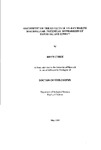ASSESSMENT OF THE EFFECTS OF UV-B IN MARINE MACROALGAE: POTENTIAL BIOMARKERS OF EXPOSURE AND EFFECT
| dc.contributor.author | CORDI, BRITT | |
| dc.contributor.other | School of Biological and Marine Sciences | en_US |
| dc.date.accessioned | 2013-10-21T10:26:03Z | |
| dc.date.available | 2013-10-21T10:26:03Z | |
| dc.date.issued | 1999 | |
| dc.identifier | NOT AVAILABLE | en_US |
| dc.identifier.uri | http://hdl.handle.net/10026.1/2245 | |
| dc.description.abstract |
Studies were undertaken to investigate the suitability of several molecular and physiological responses as biomarkers of UV-B exposure in several marine macroalgal species. Investigations into the sensitivity of mature plants and the reproductive unicells were also carried out. Furthermore, experiments were conducted to determine the interaction between UV-B radiation and the antifouling compound Irgarol 1051 in both a fouling alga and two non-target algal species. Chlorophyll fluorescence, in vivo thallus absorptance and ion leakage were investigated for their suitability as physiological biomarkers of UV -B exposure in the intertidal alga Enteromorpha intestinalis and the subtidal alga Palmaria palmata. DNA damage (measured by Random Amplification Polymorphic DNA fingerprinting, RAPD) and the cellular stress response (measured by induction of the heat shock 70 protein, HSP 70) were evaluated as molecular biomarkers of UV-B exposure. Measurements of thallus growth were used as a measure of adverse biological effects. Fv/Fm ratio showed potential as a sensitive, nonspecific general biomarker of UV-B exposure in both E. intestinalis and P. palmata. In vivo absorptance at wavelengths corresponding to chlorophyll a, phycoerythrin and/or carotenoids, as well as phycoerythrobilin and phycocyanin decreased in a dose-response dependent manner with UV-B exposure. These changes were associated with decreases in growth rate in P. palmata. The RAPD technique used for measuring DNA damage, showed potential as a tool for assessing UV -induced toxicity. These results illustrated that utilising several responses from different levels of biological organisation offer greater possibilities for detecting UV-B induced effects than do single responses. Experiments with 12 h old reproductive unicells of E. intestinalis demonstrated that asexual zoospores were up to 6 times more sensitive to UV-B exposure than mature thalli (measured as variable fluorescence). After 1 hour exposure to elevated UV-B (equivalent to 27% ozone depletion) reproductive unicells experienced decreases in variable fluorescence, accompanied by a 50 % inhibition of germination success and 16.4 % reduction in growth rates. Moreover, consistent patterns of greater sensitivity in the sexual reproductive part of the life cycle compared to the asexual part of the life cycle emerged throughout the experiments. The interactive relationship between UV-B radiation and the s-triazine Irgarol 1051 was investigated in multi-factorial experiments. Inhibitions in optimal quantum yield of approximately 20% were found after exposure to UV-B or Irgarol 1051 (applied singly). When these two stressors were applied simultaneously, however, an additive effect resulting in further reductions of up to 19.6 % compared to a single treatment occurred. These decreases in Fv/Fm were accompanied by up to a 38.5 % reduction in growth rates. Simultaneous exposure of the same stressors to two non-target macroalgae, P. palmata and P. umbilicalis, revealed that these algae were less sensitive to Irgarol 1051 compared to E. intestinalis. However, similar additive effects measured as reductions in both Fv/Fm ratio and growth rates occurred after simultaneous exposure. These results underline the importance of investigating combination effects between UV-B radiation and xenobiotic compounds, if an under-estimation of the ecological implications of elevated UV-B exposure in the marine environment is to be avoided. | en_US |
| dc.language.iso | en | en_US |
| dc.publisher | University of Plymouth | en_US |
| dc.title | ASSESSMENT OF THE EFFECTS OF UV-B IN MARINE MACROALGAE: POTENTIAL BIOMARKERS OF EXPOSURE AND EFFECT | en_US |
| dc.type | Thesis | |
| dc.identifier.doi | http://dx.doi.org/10.24382/3402 | |
| dc.identifier.doi | http://dx.doi.org/10.24382/3402 |
Files in this item
This item appears in the following Collection(s)
-
01 Research Theses Main Collection
Research Theses Main


